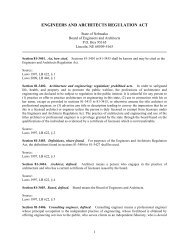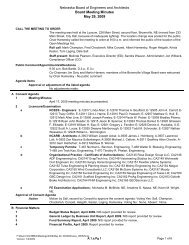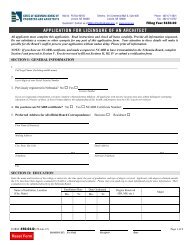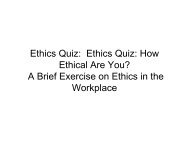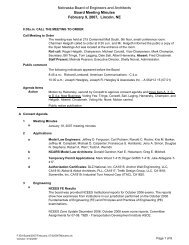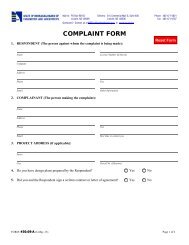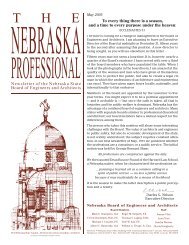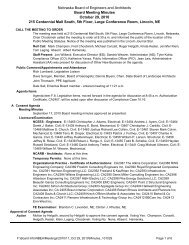Architecture Case St dies Case Studies and Applicable AIA Code ...
Architecture Case St dies Case Studies and Applicable AIA Code ...
Architecture Case St dies Case Studies and Applicable AIA Code ...
You also want an ePaper? Increase the reach of your titles
YUMPU automatically turns print PDFs into web optimized ePapers that Google loves.
Design Professional Ethics<br />
<strong>Architecture</strong><br />
<strong>Case</strong> <strong>St</strong>u<strong>dies</strong><br />
<strong>and</strong><br />
<strong>Applicable</strong> <strong>AIA</strong> <strong>Code</strong> Sections<br />
pg. 1
<strong>Case</strong> <strong>St</strong>udy # 1<br />
Design Professional Ethics<br />
• An architect spent over thirty years developing<br />
expertise <strong>and</strong> personal credibility in health care<br />
facility design <strong>and</strong> retired at age 65;<br />
• Some months later, a competing firm invited the<br />
architect to serve as a consultant for an upcoming<br />
proposal;<br />
• The architect agreed <strong>and</strong> provided the firm with<br />
graphics <strong>and</strong> photographs of completed projects<br />
from his previous work;<br />
pg. 2
Design Professional Ethics<br />
• The proposal was prepared <strong>and</strong> submitted for<br />
a large hospital expansion project;<br />
• Thereafter the architect’s former employer<br />
submitted almost the exact same materials<br />
<strong>and</strong> examples of work;<br />
• The client, wanting to avoid an<br />
uncomfortable situation, rejected both<br />
proposals.<br />
pg. 3
Design Professional Ethics<br />
• Question: What were some of the ethical<br />
issues involved in this case?<br />
pg. 4
Design Professional Ethics<br />
Issue: Attribution<br />
• The most common violation i of the <strong>AIA</strong> A <strong>Code</strong> of<br />
Ethics is improper attribution;<br />
• Creativity it <strong>and</strong> design innovation is highly hl prized in<br />
architecture;<br />
• The collaborative nature of practice makes<br />
individual contribution difficult to define or<br />
document;<br />
• Dynamic <strong>and</strong> fluid nature of practice <strong>and</strong> the market<br />
attribution complicated <strong>and</strong> problematic<br />
pg. 5
Design Professional Ethics<br />
• Assigning proper attribution is further<br />
complicated by the wide variety of media;<br />
• Printed proposals, websites, mailers,<br />
PowerPoint presentations <strong>and</strong> e-mail all offer<br />
complexities of presentation <strong>and</strong> scale that<br />
require individual solutions.<br />
pg. 6
Design Professional Ethics<br />
• <strong>AIA</strong> <strong>Code</strong> of Ethics - Ethical <strong>St</strong><strong>and</strong>ard 4.2:<br />
Dignity i <strong>and</strong> Integrity. Members should<br />
strive, through their actions, to promote the<br />
dignity i <strong>and</strong> integrity i of the profession, <strong>and</strong> to<br />
ensure that their representatives <strong>and</strong><br />
employees conform their conduct to this<br />
<strong>Code</strong>.<br />
pg. 7
Design Professional Ethics<br />
• <strong>AIA</strong> <strong>Code</strong> of Ethics - Ethical <strong>St</strong><strong>and</strong>ard 5.3.<br />
Members should provide their associates <strong>and</strong><br />
employees with a suitable working<br />
environment, compensate them fairly, <strong>and</strong><br />
facilitate their professional development.<br />
pg. 8
Design Professional Ethics<br />
• <strong>AIA</strong> <strong>Code</strong> of Ethics – Rule 4.201: Members<br />
shall hllnot make misleading, il deceptive, or fl false<br />
statements or claims about their professional<br />
qualifications, i experience, or performance<br />
<strong>and</strong> shall accurately state the scope <strong>and</strong><br />
nature of their responsibilities i in connection<br />
with work for which they are claiming credit.<br />
pg. 9
Design Professional Ethics<br />
• <strong>AIA</strong> <strong>Code</strong> of Ethics – Rule 5.301: Members<br />
shall hllrecognize <strong>and</strong> respect the professional<br />
contributions of their employees, employers,<br />
professional colleagues, <strong>and</strong> business<br />
associates.<br />
pg. 10
Design Professional Ethics<br />
• NCARB Rules of Conduct Rule 3.2.: An<br />
architect shall accurately represent to a<br />
prospective or existing client his/her<br />
qualifications, i capabilities, i experience, <strong>and</strong><br />
the scope of his/her responsibility in<br />
connection with work for which h he/she h is<br />
claiming credit.<br />
pg. 11
Commentary<br />
Design Professional Ethics<br />
• <strong>Case</strong> illustrates the overlap that sometimes<br />
exists between law <strong>and</strong> ethics <strong>and</strong> how ethics<br />
(e.g. trade secrets, confidentiality, copyright,<br />
etc.)<br />
pg. 12
Design Professional Ethics<br />
<strong>Case</strong> <strong>St</strong>udy # 2<br />
• An architect was asked to design a strip<br />
shopping center in a suburban community;<br />
• The client had completed several similar<br />
projects, however, previous projects were not<br />
as large as the new project;<br />
• Although not particularly enthusiastic, the<br />
architect recognized that the project could be<br />
profitable <strong>and</strong> also offer design opportunities;<br />
pg. 13
Design Professional Ethics<br />
• The architect was also hesitant because the<br />
architect’s previous experience was limited to<br />
residential projects, including the client’s home;<br />
• The client’s program called for 34,000 square feet<br />
of retain space;<br />
• The client assured the architect that commercial<br />
design was not difficult <strong>and</strong> supplied drawings <strong>and</strong><br />
specifications from previous projects to provide an<br />
idea of the projects complexity <strong>and</strong> requirements;<br />
pg. 14
Design Professional Ethics<br />
• The client also had in-house staff to assist<br />
with ihcost estimation, i material <strong>and</strong> system<br />
selections, bidding <strong>and</strong> negotiation with<br />
contractors, <strong>and</strong> project supervision;<br />
i<br />
• The architect was advised that he developer’s<br />
staff typically h<strong>and</strong>led all of the day to day<br />
work during construction <strong>and</strong> that<br />
construction contract administration would<br />
not be required;<br />
pg. 15
Design Professional Ethics<br />
• The architect completed the work as<br />
contracted <strong>and</strong>, through the mechanical<br />
engineer, specified mechanical systems<br />
recommended by the client;<br />
• The structural engineer relied on the soil test<br />
provided by the client;<br />
• The project proceeded appropriately, the<br />
architect performed the requested services,<br />
produced the required construction drawings<br />
<strong>and</strong> was paid as agreed;<br />
pg. 16
Design Professional Ethics<br />
• When the project was put out to bid, costs exceeded<br />
the owner expectations by 30%;<br />
• The owner asked the architect to redesign the<br />
project to bring it in on budget, however, no<br />
directions were provided on necessary program<br />
adjustments to reduce costs;<br />
• The architect explained to the owner that in the<br />
current market, ,price escalations on material <strong>and</strong><br />
labor were to be expected <strong>and</strong> a reduction in scope<br />
would be necessary to reduce the budget;<br />
pg. 17
Design Professional Ethics<br />
• The owner decides to build the project as<br />
originally i<br />
drawn;<br />
• Following completion <strong>and</strong> for the next two<br />
years after occupancy, there were continual<br />
problems with the mechanical systems;<br />
• Constant repairs were required <strong>and</strong>, after two<br />
years, all main air-h<strong>and</strong>ling units had to be<br />
replaced;<br />
pg. 18
Design Professional Ethics<br />
• Cracks in the ceramic floor tiles in several<br />
retail spaces were evidence of cracks in<br />
concrete slabs;<br />
• Although the cracks were not substantial,<br />
they resulted in tenant complaints.<br />
pg. 19
Design Professional Ethics<br />
• Question: What were some of the ethical<br />
issues involved in this case?<br />
pg. 20
Design Professional Ethics<br />
Issue: Qualifications<br />
• Presentation of qualifications is often<br />
problematic;<br />
• It is human nature to want to present one’s<br />
credentials in the best possible light;<br />
• In competitive situations, trying to convince a<br />
new client or existing firm to hire an architect<br />
can create unrealistic expectations;<br />
pg. 21
Design Professional Ethics<br />
• Although legal <strong>and</strong> contractual obligations<br />
are generally well-defined, dfi dproject goals,<br />
client needs, building functions <strong>and</strong> other<br />
competitive ii factors place pressure on the<br />
architect <strong>and</strong> often make practice issues more<br />
subjective <strong>and</strong> more open to interpretation.<br />
i<br />
pg. 22
Design Professional Ethics<br />
• <strong>AIA</strong> <strong>Code</strong> of Ethics – Rule 1.101: In<br />
practicing ii architecture, members shall hll<br />
demonstrate a consistent pattern of<br />
reasonable care <strong>and</strong> competence, <strong>and</strong> shall<br />
apply the technical knowledge <strong>and</strong> skill<br />
which h is ordinarily il applied by architects of<br />
good st<strong>and</strong>ing practicing in the same locality<br />
pg. 23
Design Professional Ethics<br />
• <strong>AIA</strong> <strong>Code</strong> of Ethics – Rule 3.102: Members<br />
shall hllundertake to perform professional<br />
services only when they, together with those<br />
whom they may engage as consultants, are<br />
qualified by education, training, or<br />
experience in the specific technical areas<br />
involved.<br />
pg. 24
Design Professional Ethics<br />
• NCARB Rules of Conduct – Rule 1.3: An<br />
architect shall undertake to perform<br />
professional services only when he/she,<br />
together with those who the architect may<br />
engage as consultants, is qualified by<br />
education, training, i <strong>and</strong> experience in the<br />
specific technical areas involved.<br />
pg. 25
Design Professional Ethics<br />
• The realities of the design <strong>and</strong> construction<br />
industry <strong>and</strong> the job market underscore the<br />
importance of qualifications in relation to<br />
ethics;<br />
• Practice evolves over time <strong>and</strong> new<br />
competencies are developed with existing<br />
employees though practice <strong>and</strong> education;<br />
• However, expertise in a specific building<br />
type may be lost through staff attrition;<br />
pg. 26
Design Professional Ethics<br />
Commentary:<br />
• In addition to misstating qualifications, architects<br />
are often compelled to make statements about<br />
projects that could unintentionally yprove<br />
misleading;<br />
• Comments regarding budget or timing made in an<br />
informal manner may be misconstrued as<br />
commitments, it is incumbent upon the firm <strong>and</strong> the<br />
principals, p to assure that proposals, p marketing<br />
materials <strong>and</strong> statements accurately represent the<br />
firm’s current capabilities <strong>and</strong> resources.<br />
pg. 27
Design Professional Ethics<br />
<strong>Case</strong> <strong>St</strong>udy # 3<br />
• An architect was hired in the design of a<br />
single family home for a young couple;<br />
• A revision in the agreement excluded the<br />
architect from a specific budget, although the<br />
approximate size of the house was defined;<br />
• By their own estimation, the owners had a<br />
reasonable budget;<br />
pg. 28
Design Professional Ethics<br />
• However the architect was concerned about<br />
their hi budget bd <strong>and</strong>, at the completion of fh the<br />
schematic design, offered to have three<br />
contractors review the drawings <strong>and</strong> provide<br />
preliminary cost estimates;<br />
• Based on three favorable estimates, the<br />
clients directed the architect to continue with<br />
the construction drawings’;<br />
pg. 29
Design Professional Ethics<br />
• The final drawings did not alter the scope of<br />
the project;<br />
• However, additional details were provided<br />
defining the foundation, structural<br />
components <strong>and</strong> architectural features;<br />
• When the drawings were put out for bid, the<br />
cost of construction had escalated beyond the<br />
client’s resources;<br />
pg. 30
Design Professional Ethics<br />
• Even though the reasons for the cost<br />
increases were strictly market-driven, di the<br />
clients were upset.<br />
pg. 31
Design Professional Ethics<br />
• Question: What were some of the ethical<br />
issues involved in this case?<br />
pg. 32
Design Professional Ethics<br />
Issue: Expectations <strong>and</strong> Results<br />
• Responsibility for cost is a common<br />
complaint against architects;<br />
• An architect’s restraint in discussing<br />
expectations related to budget, building<br />
function, quality of materials <strong>and</strong> other<br />
anticipated results of the proposed p services<br />
may help to minimize potential<br />
misrepresentation;<br />
pg. 33
Design Professional Ethics<br />
• Contractual definition of all parties’<br />
responsibilities <strong>and</strong> reiteration of this<br />
definition as the project progresses can<br />
further minimize potential misrepresentation.<br />
pg. 34
Design Professional Ethics<br />
• <strong>AIA</strong> <strong>Code</strong> of Ethics – Rule 3.103: Members<br />
shall not materially alter the scope or<br />
objectives of a project without the client’s<br />
consent.<br />
pg. 35
Design Professional Ethics<br />
• <strong>AIA</strong> <strong>Code</strong> of Ethics – Rule 3.301: Members<br />
shall not intentionally or recklessly mislead<br />
existing or prospective clients about the<br />
results that can be achieved through the use<br />
of the member’s services, nor shall the<br />
members state that they can achieve results<br />
by means that violate applicable law or this<br />
<strong>Code</strong>.<br />
pg. 36
Commentary:<br />
Design Professional Ethics<br />
• The medical profession uses the concept of<br />
“informed consent” in which a patient must<br />
be informed of a situation to a level of<br />
underst<strong>and</strong>ing that allows for the patient to<br />
make an informed decision;<br />
• Architectural clients deserve <strong>and</strong> often<br />
dem<strong>and</strong> the same consideration;<br />
pg. 37
Design Professional Ethics<br />
• In order to achieve this, it is critical to keep<br />
expectations realistic, i <strong>and</strong> attainable;<br />
• Frequent verbal <strong>and</strong> written communication<br />
with the client at every stage of the project is<br />
a st<strong>and</strong>ard practice that architects employ to<br />
keep the project on track;<br />
• It also keeps the client involved, up to date,<br />
<strong>and</strong> able to make informed decisions that<br />
minimize potential misrepresentations.<br />
pg. 38
Design Professional Ethics<br />
<strong>Case</strong> <strong>St</strong>udy # 4<br />
• An architect who had worked for a firm for<br />
just over six years, was offered a position<br />
with a competing firm;<br />
• The new firm offered higher pay <strong>and</strong> new<br />
opportunities for growth;<br />
• The architect accepted the offer <strong>and</strong> provided<br />
two weeks notice;<br />
pg. 39
Design Professional Ethics<br />
• Although the architect offered to complete<br />
project responsibilities, i the firm declined d <strong>and</strong><br />
terminated the employment contract<br />
immediately;<br />
• The firm agreed to compensate the architect<br />
for outst<strong>and</strong>ing vacation time, however, the<br />
firm offered no other severance or assistance;<br />
pg. 40
Design Professional Ethics<br />
• During six years with the firm, the architect’s<br />
responsibilities i ranged from drafting <strong>and</strong><br />
CAD operation to project design <strong>and</strong> finally<br />
project management;<br />
• The firm’s marketing department possessed<br />
extensive project documentation, renderings<br />
by professional illustrators depicting his<br />
projects <strong>and</strong> a professional photographer<br />
documented completed projects;<br />
pg. 41
Design Professional Ethics<br />
• The firm also produced in-house computerdimages<br />
of some of the projects;<br />
generated • The architect believed he was entitled to<br />
copies of project renderings <strong>and</strong> photographs;<br />
• The architect was willing to pay for the<br />
copies but the firm was not cooperative;<br />
• Architect makes copies of some of the<br />
documents without advising the firm<br />
pg. 42
Design Professional Ethics<br />
• Question: What were some of the ethical<br />
issues involved in this case?<br />
pg. 43
Design Professional Ethics<br />
Issue: Examples of Work<br />
• For a wide variety of reasons, obtaining<br />
examples of professional work, particularly<br />
from a previous employer or firm, can be<br />
difficult <strong>and</strong> occasionally can result in an<br />
ethical violation;<br />
• Defining an architect’s role <strong>and</strong> specific work<br />
product can be difficult with today’s complex<br />
projects <strong>and</strong> electronic technologies;<br />
pg. 44
Design Professional Ethics<br />
• Rights <strong>and</strong> obligations of both employee <strong>and</strong><br />
firm must be protect;<br />
• However, technological complexities <strong>and</strong><br />
differing viewpoints make honoring both<br />
firm rights <strong>and</strong> employee rights problematic.<br />
pg. 45
Design Professional Ethics<br />
• <strong>AIA</strong> <strong>Code</strong> of Ethics – Rule 5.302: Members<br />
leaving a firm shall not, without the<br />
permission of their employer or partner, take<br />
design, drawings, data, reports, notes, or<br />
other materials, relating to the firm’s work,<br />
whether or not performed by the member.<br />
pg. 46
Design Professional Ethics<br />
• <strong>AIA</strong> <strong>Code</strong> of Ethics – Rule 5.303: Members<br />
shall not unreasonably withhold permission<br />
from a departing employee or partner to take<br />
copies of designs, drawings, data, reports,<br />
notes, or other materials relating to work<br />
performed by the employee or partner that<br />
are not confidential.<br />
pg. 47
Commentary:<br />
Design Professional Ethics<br />
• Employees rightfully expect to be permitted<br />
to retain <strong>and</strong> use reasonable documentation<br />
of their professional experience with a firm;<br />
• Determining which examples of projects<br />
might be useful in the future is not an issue<br />
that most employees consider during<br />
employment;<br />
pg. 48
Design Professional Ethics<br />
• Because departure from a firm or termination<br />
of employment is often awkward, emotional,<br />
or even volatile, the discussion of the right to<br />
retain examples of work is often overlloked<br />
or carefully avoided.<br />
pg. 49
Design Professional Ethics<br />
• Employers are not obligated to make the<br />
entire documentation available to employees;<br />
• Firms have an interest in retaining control of<br />
confidential materials <strong>and</strong> the work product it<br />
rightfully owns, such as copyrighted<br />
drawings, renderings, photography, or<br />
proprietary software.<br />
pg. 50
Design Professional Ethics<br />
Other Issue: Conflicting Loyalties<br />
• Honesty – at face value – seems easy enough,<br />
even effortless for most of us;<br />
• However, principled professionals are<br />
occasionally ypresented with competing<br />
obligations;<br />
• Business <strong>and</strong> financial responsibilities,<br />
family duties or professional aspirations <strong>and</strong><br />
other considerations could easily conflict;<br />
pg. 51
Design Professional Ethics<br />
• For example, an employee may decide to<br />
“moonlight” to build a client base, take<br />
advantage of opportunities to demonstrate<br />
design creativity, i or simply make extra<br />
money;<br />
• In doing so, the employee could unwittingly<br />
expose the firm to liability;<br />
• The employee may even compromise their<br />
own performance;<br />
pg. 52
Design Professional Ethics<br />
• Moonlighting is generally discouraged <strong>and</strong><br />
often formally restricted by company policy;<br />
• An employee may decide to use the firm’s<br />
software for personal use, believing (or<br />
rationalizing) that no harm is done or that the<br />
firm can easily afford it.<br />
pg. 53
Design Professional Ethics<br />
Summary <strong>and</strong> Conclusion<br />
pg. 54



